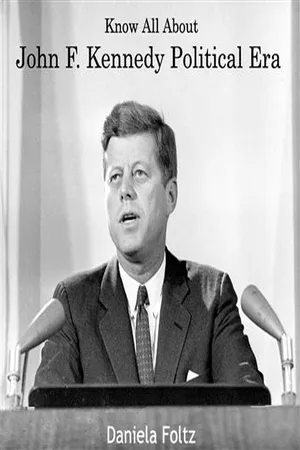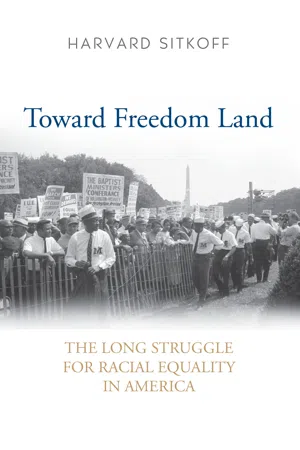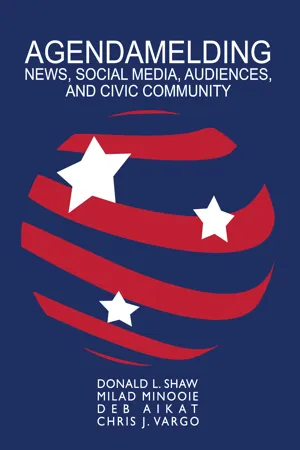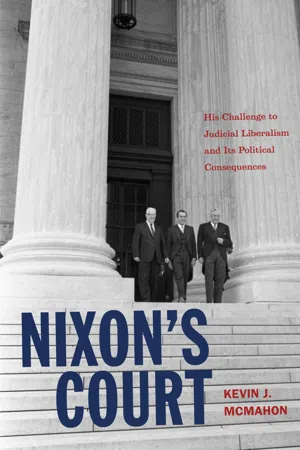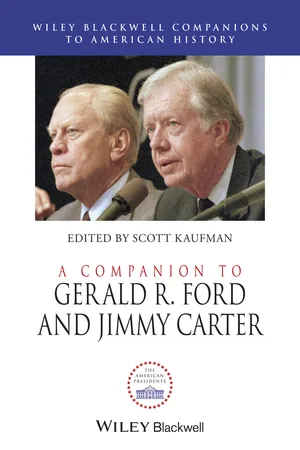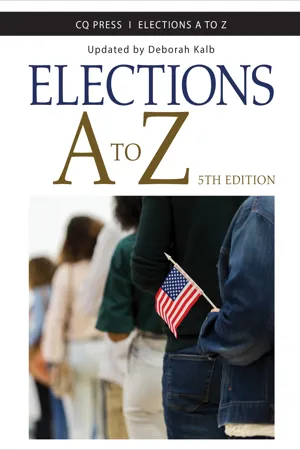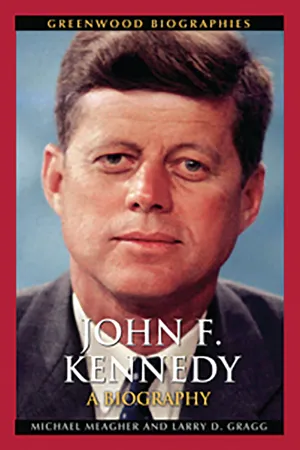History
1968 Presidential Election
The 1968 election in the United States was a pivotal moment in American politics. It was marked by significant events such as the assassination of Robert F. Kennedy and the tumultuous Democratic National Convention in Chicago. Richard Nixon ultimately won the presidency, marking a shift in the political landscape and setting the stage for significant changes in the years that followed.
Written by Perlego with AI-assistance
Related key terms
1 of 5
10 Key excerpts on "1968 Presidential Election"
- eBook - ePub
US Presidential Elections and Foreign Policy
Candidates, Campaigns, and Global Politics from FDR to Bill Clinton
- Andrew Johnstone, Andrew Priest, Andrew Johnstone, Andrew Priest(Authors)
- 2017(Publication Date)
- The University Press of Kentucky(Publisher)
2 Nixon’s early political reputation had been built on his hardline foreign policy credentials and particularly his image as a champion of exposing domestic subversion. But all three candidates in 1968 adhered to the basic principles of the Cold War consensus, especially with regard to the containment doctrine. With regard to the increasingly unpopular war in Vietnam, each promised policy alternatives that would bring the war to a successful conclusion, but none identified a coherent strategy for ending the war on terms that would secure the basic goals of providing for South Vietnam’s independence and upholding US credibility. Furthermore, there was little of significance to truly distinguish the positions of Humphrey and Nixon on Vietnam, while Wallace fell back on the familiar refrain that he would simply hand management of the war over to the armed forces and thereby end US involvement quickly. The candidates’ ambivalence reflected public opinion; while a majority of Americans polled believed that US military intervention had been a mistake, only a very small minority countenanced withdrawal should it lead to a North Vietnamese takeover of the South. The war clearly informed daily discourse on the most important threats facing the nation, and, as this chapter will argue, it played a key role in defining who was deemed most competent when it came to managing the nation’s problems. But, given the lack of difference in policy terms between Nixon and Humphrey, the war’s function in determining how people voted on Election Day is more difficult to gauge.Scholars have championed the relevance of foreign policy to the 1968 Presidential Election, but there is no consensus as to its meaning on Election Day. Melvin Small declared 1968 “the foreign policy election of the twentieth century.” “Vietnam,” he asserted, “was the central issue in the campaign, defining the terms of battle for the nominations and the trajectory of political discourse.”3 Small acknowledged that it had “always been clear that the 1968 election was not a referendum on the war,” but he maintained: “The fact that Americans did not vote on the war on Election Day did not mean that the war was not the overriding issue in the run-up to the November showdown.”4 Julian Zelizer also posited that “discord over Vietnam shaped the presidential election of 1968” and signaled the “imperiled” condition of both the Democratic Party and its liberal internationalist agenda.5 The Tet Offensive of January 1968, Walter LaFeber suggested, “marked the turning point of both the war and the U.S. presidential campaign of 1968.”6 The centrality of Vietnam to this presidential election was signaled by early accounts, most notably Lewis Chester, Godfrey Hodgson, and Bruce Page’s opinion-shaping An American Melodrama, published in 1969. “Nothing is clearer,” the British journalists stated, “than the imperative that an account of the politics of 1968 must start with Vietnam, the progress of which dominated the struggle for the Presidency from first to last.” Yet they further posited: “The nature of its effect was not always agreed upon; it was often more oblique than was supposed; the war was perhaps not the simple and overriding moral issue that many honest crusaders perceived it to be.”7 - No longer available |Learn more
- (Author)
- 2014(Publication Date)
- The English Press(Publisher)
There has been controversy among some historians as to whether vote theft in selected states aided Kennedy's victory. This election saw Southern anger at the pro-civil rights stances of Kennedy and Nixon. Mississippi and Alabama sent uncommitted electors to the Electoral College: eventually, these voted for Harry F. Byrd, segregationist Democrat Senator from Virginia, for President, and Strom Thurmond, segregationist Democratic Senator from South Carolina, ________________________ WORLD TECHNOLOGIES ________________________ for Vice-President. A faithless elector from Oklahoma voted for Byrd for President and Barry Goldwater, a Republican senator from Arizona, for Vice-President. This was the first presidential election in which Alaska and Hawaii participated, having been granted statehood, respectively, on January 3 and August 21 of the previous year. It was also the first election in which both candidates for president were born in the 20th century. This is also the most recent election where the candidate who carried Ohio did not win the overall election, and the first ever when a Democrat was elected President without carrying Florida (although this happened again in 1992). Kennedy was inaugurated in 1961, serving almost three years before he was assassinated in 1963. Nixon went on to return in the 1968 election and served as President from 1969 to 1974, being re-elected in 1972. Nominations Democratic Party Democratic candidates • John F. Kennedy, U.S. senator from Massachusetts. • Lyndon B. Johnson, U.S. senator and Majority Leader from Texas. • Stuart Symington, U.S. senator from Missouri. • Adlai E. Stevenson, former governor of Illinois. • Hubert H. Humphrey, U.S. senator from Minnesota. • Wayne Morse, U.S. senator from Oregon. • Edmund G. Brown, governor of California. Senator John F. Kennedy of Massachusetts Senator and Majority Leader Lyndon B. - eBook - ePub
Toward Freedom Land
The Long Struggle for Racial Equality in America
- Harvard Sitkoff(Author)
- 2010(Publication Date)
- The University Press of Kentucky(Publisher)
Harry Truman andthe Election of 1948The Coming of Age of Civil Rightsin American Politics
Yet another essay written in the late 1960s, when I proudly considered myself a New Leftist, “Harry Truman and the Election of 1948” began as a bill of indictment, a categorical denunciation of liberals for doing too little, too late. It then became a critique of Truman as, at best, a reluctant champion of civil rights, pressured by forces beyond his control. It concluded, nevertheless, with civil rights benefiting from being identified with the president of the United States and with the Democratic Party. All motives aside, that sparked ever-rising expectations of African Americans and ever-increasing pressures on the political system to respond to those expectations. Indicative of the then swelling tide of revisionism, characterized by a strong animosity toward American liberalism, “Harry Truman and the Election of 1948” was awarded the Fletcher M. Green Award for best essay submitted by a graduate student to theJournal of Southern History,1970–1972. Written in the same period, but a more radical statement of the revisionist case against liberalism in general and against the significance of Truman’s civil rights program in particular, is my “Years of the Locust: Interpretations of Truman’s Presidency since 1965,” inThe Truman Period as a Research Field: A Reappraisal, 1972,ed. Richard Kirkendall (Columbia: University of Missouri Press, 1974), 75–112. “Harry Truman and the Election of 1948: The Coming of Age of Civil Rights in American Politics” was originally published inJournal of Southern History 37 (November 1971), 597–616 .A year before the national election of 1948 Clark M. Clifford, an administrative assistant and special counsel to the president, presented a forty-three-page confidential memorandum to Harry S. Truman. The memo, referred to as “The Politics of 1948,” suggested the electoral strategy for Truman in the upcoming election. Clifford particularly emphasized the importance of the Negro vote, warning that because of Henry A. Wallace’s growing identification with the civil rights issue and Thomas E. Dewey’s presumed popularity with Negro leaders, as well as the Republican policy of embarrassing the Democrats by publicly favoring anti–poll tax and antilynching legislation, Truman would lose the Negro vote unless he acted decisively. “Unless there are new and real efforts,” wrote Clifford, “(as distinguished from mere political gestures which are today thoroughly understood and strongly resented by sophisticated Negro leaders), the Negro bloc . . . will go Republican.” In order to outbid the Republicans and steal Henry Wallace’s thunder, the president must “go as far as he feels he possibly could go in recommending measures to protect the rights of minority groups.” Administration strategy must be premised on the assumption that “it will get no major part of its program approved. Its tactics must, therefore, be entirely different than if there were any real point to bargaining and compromise. Its recommendations . . . must be tailored for the voter, not the Congressman; they must display a label which reads ‘no compromises.’” Clifford confidently predicted that Truman’s espousal of civil rights would not lose him southern support. “As always, the South can be considered safely Democratic,” he concluded, “and in formulating national policy, it can be safely ignored.”1 - eBook - PDF
Agendamelding
News, Social Media, Audiences, and Civic Community
- Donald L. Shaw, Milad Minooie, Deb Aikat, Chris J. Vargo(Authors)
- 2019(Publication Date)
The distance between the markers and horizontal lines (if any) represents the error. Source: Authors. Richard Nixon vs. George McGovern, 1972 Newspapers and television likewise informed voters during the presidential campaign in 1972 between President Nixon and Democratic challenger George McGovern, a U.S. senator from South Dakota. At the end of his first term as president, Nixon was in the process of trying to disentangle from the American involvement in the Vietnam War and on the precipice of opening 140 agendamelding relations with Communist China. In the 1972 campaign, perhaps the most important event from the point of view of Nixon’s long-term administration was the effort by a group of Republican operatives to break into the Demo- cratic National Committee (DNC) headquarters at the Watergate office com- plex in Washington, D.C. An FBI investigation connected the operatives with Nixon’s reelection campaign, the Committee for the Re-election of the Pres- ident (CRP). As evidence continued to mount against the president’s staff, it was revealed by a Senate committee tasked with investigating Watergate that Nixon had been recording conversations at his offices. A unanimous decision by the Supreme Court forced Nixon to release the tapes, which implicated him in the attempted cover up of the break-in and obstruction of the inves- tigation. Facing imminent impeachment, Nixon resigned on August 9, 1974 and was subsequently pardoned by his successor Gerald Ford. McGovern was a reformer within the Democratic Party, still remembering the protests and clashes at the 1968 Democratic National Convention that selected his predecessor, Hubert Humphrey. McGovern attempted to democ- ratize this nomination process by redesigning it and came to benefit from the reforms he created in the 1972 primaries. McGovern, as a candidate from South Dakota, reflected the American heartland’s commitment to individu- alism and social service. - eBook - ePub
Nixon's Court
His Challenge to Judicial Liberalism and Its Political Consequences
- Kevin J. McMahon(Author)
- 2011(Publication Date)
- University of Chicago Press(Publisher)
Perhaps worst of all for segregationists, Nixon had once referred to Earl Warren as “that great Republican Chief Justice.” 60 Nixon’s relatively consistent record on racial equality, therefore, made it difficult for him to become a civil rights turncoat in 1968. More important, he thought pursuing such a path would be damaging to his electoral chances, just as Goldwater’s blatant attempt to move into the South had disaffected traditional Republican voters and failed miserably. Indeed, before the Arizona senator’s nomination, Nixon, hoping to be chosen as a compromise candidate at the convention, suggested that “it would be a tragedy if Senator Goldwater’s views as previously stated were not challenged and repudiated.” 61 Four years later, on election night, Nixon won a narrow 302 electoral vote victory. Humphrey captured 191 electoral votes. If Nixon had lost his home state of California—which he won by a mere 3.1 percent—the race would have been thrown into the House of Representatives since George Wallace’s 45 electoral votes would have prevented either major party candidate from amassing a majority. 62 Nixon also barely hung onto his lead in the polls to win the popular vote, 43.4 percent to Humphrey’s 42.7 percent and Wallace’s 13.5 percent. Significantly, however, Nixon won in all regions of the nations, capturing four states in the Northeast, seven in the South, ten in the Midwest, and eleven in the West. He also dramatically improved his percentage among Catholics from eight years earlier. Then, against the Catholic Kennedy, he managed just 22 percent of that vote. In 1968 a third of Catholics—who as a whole made up 25 percent of the nation’s voting pool—supported his bid for the White House. Humphrey won 59 percent and Wallace 8 percent. In addition, Nixon captured 35 percent of the often-overlapping blue-collar vote - eBook - ePub
New Zealand and the Vietnam War
Politics and Diplomacy
- Roberto Rabel(Author)
- 2013(Publication Date)
- Auckland University Press(Publisher)
CHAPTER EIGHT The Domestic Politics of the Vietnam War in an Election Year, 1966 T HE DOMESTIC DEBATE ABOUT VIETNAM LAUNCHED IN 1965 would change little in character during the following year. But the general election due by the end of 1966 heightened its political significance and posed different challenges for the major participants. Holyoake was determined to build on the relatively successful public relations campaign initiated in 1965 but remained hesitant about encouraging detailed public scrutiny of the Vietnam issue. This hesitation would fade as the election drew nearer and he sensed that Vietnam could actually be an electoral asset. His Labour opponents faced the more daunting challenge of continuing to oppose a combat role without incurring the negative electoral consequences of seeming either pro-communist or too equivocal. In contrast, the anti-war movement was far from equivocal but struggled in 1966 to devise more effective ways to exert pressure on the government while grappling with problems of factionalism within its ranks and limited public support for its cause - eBook - ePub
- Scott Kaufman(Author)
- 2015(Publication Date)
- Wiley-Blackwell(Publisher)
Chapter Twenty-Six The Election of 1980 Andrew E. Busch The election of 1980 pitted Jimmy Carter against Massachusetts Senator Edward M. Kennedy and California Governor Edmund “Jerry” Brown in the Democratic primaries and caucuses, and Carter against former California Governor Ronald Reagan and Republican-turned-Independent Congressman John Anderson of Illinois in the general election. Down in the polls in the summer of 1979, Carter won his renomination against Kennedy and Brown, only to fall in the general election to Reagan. Indeed, despite a campaign during which the two major candidates seemed to be running neck and neck, Reagan won 51 percent of the nationally-aggregated popular vote in a three-way race, attaining a ten-percentage-point margin over Carter. In the Electoral College, Reagan’s win was even more decisive, with the former California governor winning all but six states and the District of Columbia and outpacing Carter 489 to 49 in electoral votes. Anderson finished with 7 percent nationally, far less than he had polled in September but enough to receive federal election funds in 1980 and (if he ran again) 1984. Reagan’s victory was accentuated by big Republican gains in Congress, raising questions whether 1980 represented an ideological mandate for Reagan or even the beginning of a realignment. The Political Context When British political scientist Anthony King edited The New American Political System (1978b), he and the other contributors sketched a comprehensive picture of the political environment, especially institutional, within which the election of 1980 would take place. Samuel Beer, for example, argued that the New Deal idea had ceased to serve as a unifying principle in American politics but that a new dominant “public philosophy” had yet to emerge - eBook - ePub
- Deborah Kalb(Author)
- 2022(Publication Date)
- CQ Press(Publisher)
While Johnson dominated most of the country, including many states that rarely voted Democratic for president, he lost five states in the Democrats’ “Solid South” along with Goldwater’s home state of Arizona. Whether caused by backlash against Johnson’s championship of the Civil Rights Act of 1964, an aversion to federal intrusion on states’ rights, or opposition to a liberal trend in the national Democratic Party, the South in 1964 began a seismic shift that ultimately would turn it into a Republican presidential stronghold.The Breakup of Consensus: 1968
A long period of uncertainty in U.S. politics began after Johnson’s landslide victory in 1964. There was rising opposition to the Vietnam War, combined with a conservative reaction to Johnson’s “Great Society” domestic economic programs and to the race-related riots in many of the nation’s cities. These issues seriously divided the nation and the Democratic Party. After Senator Eugene McCarthy of Minnesota ran surprisingly well against Johnson on an antiwar platform in the New Hampshire primary, the beleaguered president withdrew from the campaign. Vice President Hubert H. Humphrey became the administration’s candidate, relying on his strength with the party establishment and eschewing the primaries that at that time played a secondary role in the nominating process. New York senator Robert F. Kennedy, brother of the late president, entered the race as an antiwar candidate and had just gained momentum by defeating McCarthy in the California primary when he was assassinated in a Los Angeles hotel the night of his victory.The Democratic convention in Chicago was marred by skirmishes on the convention floor and bloody confrontations between police and antiwar and civil rights demonstrators outside. Democrats nominated Humphrey on the strength of endorsements from state party organizations. The nomination of a candidate who had not entered a single primary led to major changes in the way Democrats selected their delegates and ultimately to the proliferation of presidential primaries. - eBook - PDF
John F. Kennedy
A Biography
- Michael E. Meagher Ph.D., Larry D. Gragg(Authors)
- 2011(Publication Date)
- Greenwood(Publisher)
John Jr. was born two weeks later. The young First Family charmed the nation. (AP Photo) THE 1960 PRESIDENTIAL CAMPAIGN 75 of the debate format after his encounter with Jack in 1960. However, televised presidential debates have been held ever since. THE OUTCOME Jack returned to Massachusetts to await the election returns. Any hope of an early decision was quickly eliminated as the incoming results in- dicated a close race. It was much closer than Harry Truman’s surprise victory in 1948. In fact, the results were so close that Nixon gave some thought to challenging the results. Out of more than 68 million votes cast, Kennedy had defeated Nixon by only 118,574 popular votes. In the Electoral College, Kennedy received 303 votes to Nixon’s 219. He won the critical state of Illinois by a few thousand votes. There were charges that Joe Kennedy colluded with either Chicago mayor Daley or gangster Sam Giancana to ensure a positive vote in Chicago. There is no doubt that Daley threw all the resources of his political machine be- hind the Kennedy campaign, but as biographer Michael O’Brien points out, there “is the lack of evidence of any campaign activity directed by Giancana to elect Kennedy.” 19 Regardless, Jack did not need Illinois to win in the Electoral College vote. Although only 38 percent of Protes- tants voted for him, 78 percent of Roman Catholics did. Clearly, then, the Catholic issue remained problematic for many Protestant voters. Racial politics also played a role. The year 1960 marked the beginning of a trend in which African Americans voted for the Democratic Party in general, and particularly for the Democratic nominee for president. In 1956, Adlai Stevenson received 60 percent of the African American vote. In 1960, Jack received 80 percent. The nation had elected its 35th president, the first Catholic, and one of the youngest presidents in its history. - eBook - PDF
Richard Nixon, Watergate, and the Press
A Historical Retrospective
- Louis W. Liebovich(Author)
- 2003(Publication Date)
- Praeger(Publisher)
Not only was he relatively unknown, despite his two-year campaign for the nomination (the longest in history to that point), but he was a dovish, left-wing liberal whose voter base had begun to dissipate as the Vietnam War wound down. The anger of 1968, 1969, and 1970 had been replaced by an indifference to South- east Asia. The world had moved on. 52 Richard Nixon, Watergate, and the Press CONVENTION DEBACLE The July Miami convention was not what the Democrats had hoped for. After the 1968 debacle in Chicago, the rules had changed. All discussion was to be undertaken in public, and minorities and women were to be amply repre- sented. Delegations were to reflect a politically correct balance. Traditional De- mocrats, including Mayor Richard Daley of Chicago and his contingent, were left out of the convention. In return, when the general election campaign was underway, Daley and his people sat on their hands, as did many traditional party supporters. The platform included planks for peace and a cut in military expenditures, abolition of capital punishment, a ban on handguns, reform of Congress, redis- tribution of wealth through changes in tax codes, and direct election of presi- dents. These highly principled and idealistic liberal measures moved the party too far to the left for most voters. Party platforms, though usually controver- sial, historically had been hammered out in private with compromises that nei- ther wing of the party particular liked but accepted as a price for unity. In Miami, the fight was public and there were few compromises. Many factions were alienated from a political party that was losing public support anyway. The election that seemed to threaten the incumbent only a year earlier was turning into a fiasco. On Thursday, the last day of the convention, McGovern named Senator Thomas Eagleton as his vice presidential nominee. Because this was an open convention, others stepped forward on Thursday night to nominate alternative names.
Index pages curate the most relevant extracts from our library of academic textbooks. They’ve been created using an in-house natural language model (NLM), each adding context and meaning to key research topics.

